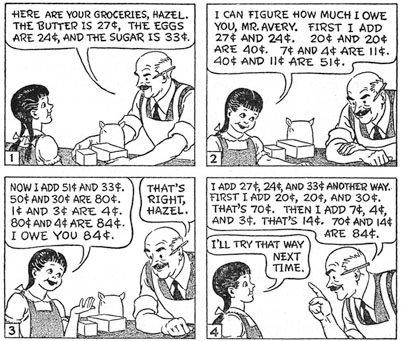I’ve been writing lately about “conceptual understanding” really being “contextual understanding” in the early grades, and even in high school. I thought an example might be appropriate, so I’ve taken a figure from a 1948 textbook for fifth grade, called “Study Arithmetics”, showing an alternate method for adding two digit numbers.
In the cartoon, the little girl knows that 27 + 24 is the same as 20+7 + 20+4, which of course is the same as 20 + 20 + 7 + 4. She then adds tens, ones, and then adds the sub-totals.
Some will say "But does she understand the concept?" What concept are we talking about then? That 27 is 20 + 7 and so forth? That 20+7+20+4 can be rearranged via the commutative rule to 20 + 7 + 20 + 4? The concept at play here is ultimately understood in the context of a collection of specific procedures.
Later on in algebra, students learn that a two digit number can be represented as 10x + y, and the sum of two such numbers can be represented as 10x + y + 10a + b, which is equivalent to 10(x+a) + y + b. Is that a concept? Again, the concept is contained within the context of a collection of algebraic procedures.
In learning math, we understand concepts initially in the context of procedures and build upon such foundations. But don't tell anyone I told you.


Let's face it: people who ask this question don't know what a concept is. 😉